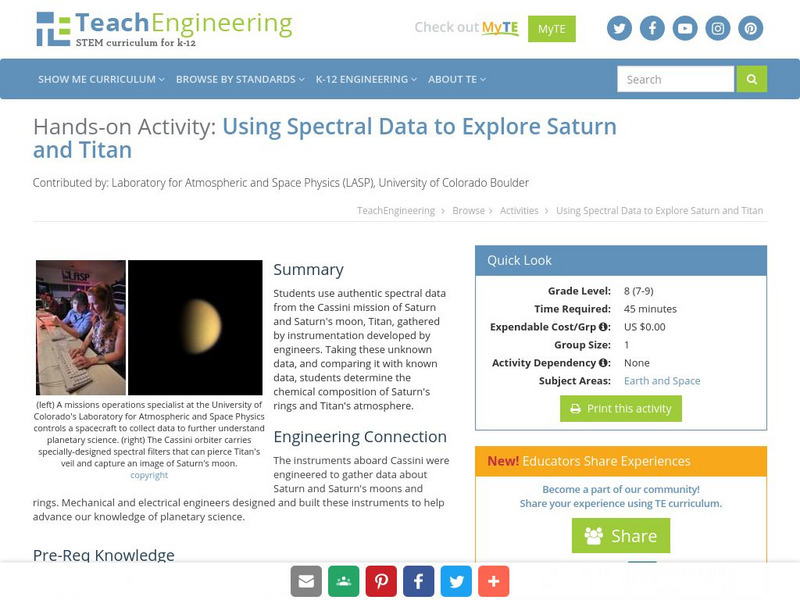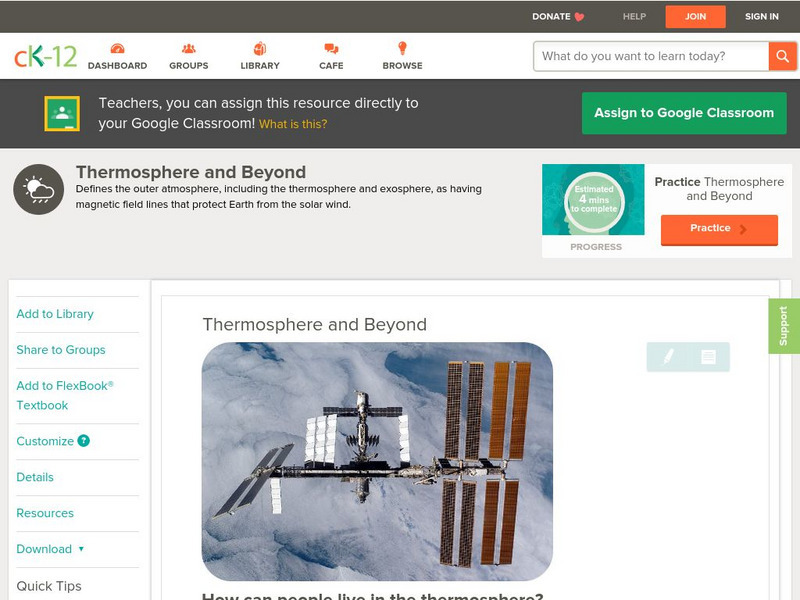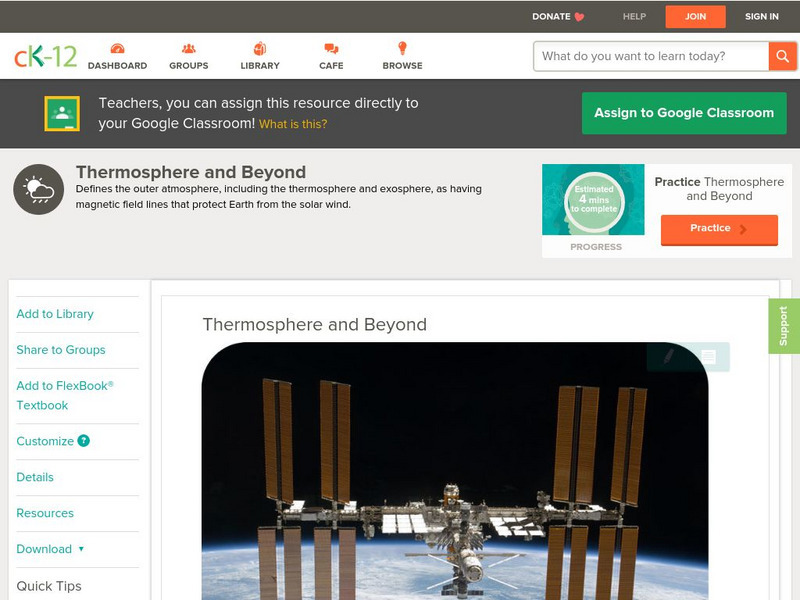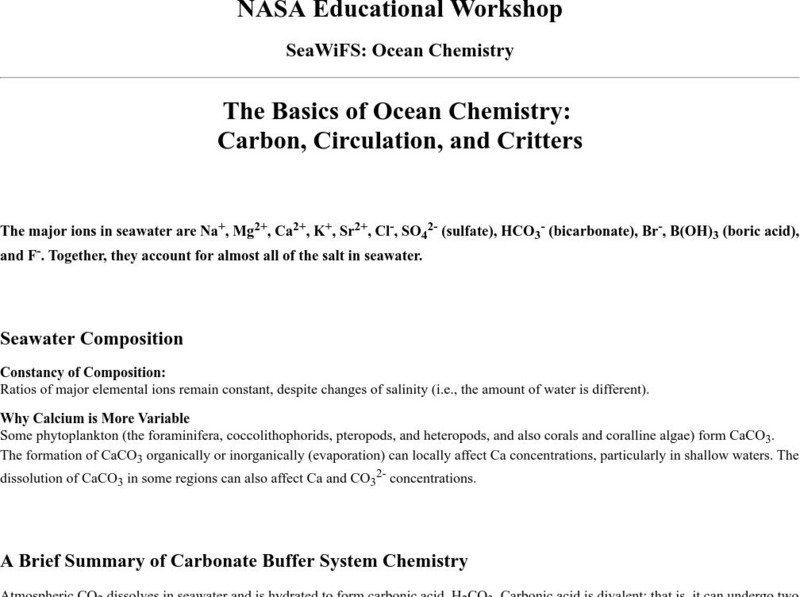NOAA
Noaa: Ocean Explorer: Off Base Acidity of Oceans
A student inquiry into properties of the ocean's carbonate buffer system, and how changes in atmospheric carbon dioxide levels may affect ocean pH and biological organisms that depend on calcification.
Science Struck
Science Struck: Facts About the Thermosphere
Learn facts about the thermosphere, one of the five layers of the atmosphere.
Science Struck
Science Struck: Exosphere Facts
Learn facts about the exosphere, one of the five layers of the atmosphere.
University Corporation for Atmospheric Research
Ucar: Thermosphere Overview
Provides an overview of the thermosphere, a layer of the Earth's atmosphere.
University Corporation for Atmospheric Research
Ucar: Exosphere Overview
Overview of the Exosphere, the uppermost region of Earth's atmosphere.
NASA
Nasa Space Place: Exosphere
Offers a brief explanation of the exosphere, the outermost layer of our atmosphere.
TeachEngineering
Teach Engineering: Using Spectral Data to Explore Saturn and Titan
Students use authentic spectral data from the Cassini mission of Saturn and Saturn's moon, Titan, gathered by instrumentation developed by engineers. Taking these unknown data, and comparing it with known data, students determine the...
ClassFlow
Class Flow: Atmospheric Layers
[Free Registration/Login Required] The Earth: The student demonstrates knowledge of how processes which shape and affect the Earth and how it relates to the Universe.
Science Education Resource Center at Carleton College
Serc: Global Warming Graph Analysis
Learners interpret a variety of graphs from Intergovernmental Panel on Climate Change reports learning the details of climate change.
Science4Fun
Science4 Fun: Neptune
Learn fun facts and details about the atmosphere, composition, and discovery of Neptune, the last planet in our solar system.
Science4Fun
Science4 Fun: Saturn
Learn fun facts and details about the atmosphere, composition, and discovery of Saturn, the second largest planet.
Science4Fun
Science4 Fun: Uranus
Learn fun facts and details about the atmosphere, composition, and discovery of Uranus, the seventh closest planet to the sun.
American Geosciences Institute
American Geosciences Institute: The Weather at High Altitudes
Learn about the air and weather that happens high up in the atmosphere.
Science Struck
Science Struck: Ionosphere Facts
Learn facts about the ionosphere. It is an extension of the thermosphere, one of the five layers of the atmosphere.
TeachEngineering
Teach Engineering: Spectroscopy
Students learn how using a spectrograph helps us understand the composition of light sources. Using simple materials and holographic diffraction gratings (available online at a variety of sites, including Edmund Scientifics and the...
TeachEngineering
Teach Engineering: Air Pollution
Students are introduced to the concept of air quality by investigating the composition, properties, atmospheric layers and everyday importance of air. They explore the sources and effects of visible and invisible air pollution. By...
BBC
Bbc: Schools: Chemistry (Single Science)
Chemistry is the study of the composition, behavior and properties of matter, and of the elements of the Earth and its atmosphere. This site provides links to chemistry exams over courses in BBC: AQA, Edexcel, Eduqas, OCR 21st Century,...
Other
British National Space Centre: Uranus
Part of a larger site on the Solar System, this page offers an image of Uranus and information about its discovery, size, orbit, and atmosphere. Follow links in the left margin to read more about the planet's composition, rotation, and...
CK-12 Foundation
Ck 12: Earth Science: Thermosphere and Beyond
[Free Registration/Login may be required to access all resource tools.] Describes the properites of the thermosphere and exosphere.
CK-12 Foundation
Ck 12: Earth Science: Thermosphere and Beyond
[Free Registration/Login may be required to access all resource tools.] Describes the properties of the thermosphere and exosphere.
NASA
Nasa Space Place: Thermosphere
A brief explanation of the thermosphere home to the International Space Station.
Other
University of Evansville: Art Studio Chalkboard
This site from the University of Evansville is a great place for the aspiring artist to visit. Receive free professional advice and tips on basic drawing techniques. The site focuses on perspective drawing and shading.
NASA
Nasa: The Basics of Ocean Chemistry: Carbon, Circulation, and Critters
An explanation of ocean chemistry, supported by illustrations, for example, of the global carbon cycle in the 1980s and the annual carbon dioxide flux. The concentration of nutrients in the ocean is discussed for its impact on marine...











